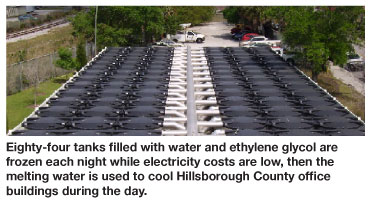 |
||||||||
 |
Hillsborough County Saves $1.2 Million
with New Focus on Energy Efficiency
 When physician John Gorrie invented air conditioning for his Apalachicola hospital in 1842, he set up a fan blowing over ice in hopes of cooling the entire building. A new take on that historic concept is helping Hillsborough County save $1.2 million a year in energy costs.
When physician John Gorrie invented air conditioning for his Apalachicola hospital in 1842, he set up a fan blowing over ice in hopes of cooling the entire building. A new take on that historic concept is helping Hillsborough County save $1.2 million a year in energy costs.
Just north of downtown Tampa, a tank farm works like a row of giant ice cubes. At night, while electricity is less expensive, 84 tanks filled with 500 gallons of water and ethylene glycol are frozen. When county employees arrive at work and temperatures start to rise, the ice is melted to create cold water. The water, in turn, runs through more than 7,000 feet of insulated underground pipe to air handlers that cool 1.5 million square feet of downtown office space.
“It works even better than we expected,” notes Randy Klindworth, the county’s energy manager. Energy use has been reduced by about 16% since 2004. Cost savings are even more dramatic because electricity costs about 55% less at night when it’s used to make ice than it would to run air conditioning systems during the day when they’re needed the most.
When the new system began operating in 2002, the county expected to recoup its $13.5 million investment in 20 years. Last year, that ROI was 7.3 years and if the trend continues, the system will pay itself back in just two more years.
Conserving electricity is important to Tampa Bay because a significant percentage of nitrogen loadings come from power plant emissions that are deposited in the bay. While the overall loadings have dropped as electric plants “repower” to natural gas, a 2002 study indicates that up to 30% of the nitrogen in Tampa Bay came from power plant emissions. |
The initiative began in 2000 when Hillsborough County joined the International Council for Local Environmental Initiatives and began developing a local action plan to limit greenhouse gases. As part of the design for the Edgecomb family court building, a new central energy plant was built to serve the court and the county’s north and south annexes with a total of about 600,000 square feet. The central energy plant was expanded in 2005 to serve the main courthouse and county center, as well as the school district’s administration building and a downtown school.
While air conditioning – which consumes about 30% of the energy used in an average office building – has been the focus of the energy-saving initiative, other steps have also been implemented:
• Lighting retrofits, replacing older fluorescent fixtures with newer, more energy-efficient models
• Occupancy sensors that automatically turn off lights if a room is left empty
• Upgrading air handlers in each building.
Two county buildings – the County Center and the Annex Complex – now qualify for the EPA’s Energy Star program and more than 20,000 tons of carbon dioxide emissions have been avoided.
Most of the technology implemented has been tried and proven in other settings, but the county implemented one unique feature: it captures about 2200 gallons of water a day created as warm air is cooled in the air handlers to recycle it back to use in the cooling towers. “It’s not typically cost effective to capture condensate but we installed the necessary pipes while the streets were already dug up for the main lines.”
Next Step: Education
With major improvements in downtown complete, Klindworth is turning his attention to creating energy teams in various county departments. “People need to be more aware of their surroundings,” he said. Setting up teams by department allows each group to address specific needs, because energy savings from the parks department may be very different from those recommended by libraries or the fire department.
And as county budgets continue to tighten, Klindworth is hopeful that employees will be even more receptive to saving energy. “The more money we save goes right to the bottom line, and maybe we’ll be able to save jobs.”
Cool Tips for a Hot Summer As a Certified Energy Manager, Klindworth specializes in managing large facilities, but also offers tips for homeowners who want to save energy and reduce their greenhouse gas emissions. Air conditioning and heating consume about 70% of the average electric use, so he focuses on cost-effective ways to cut cooling costs: |